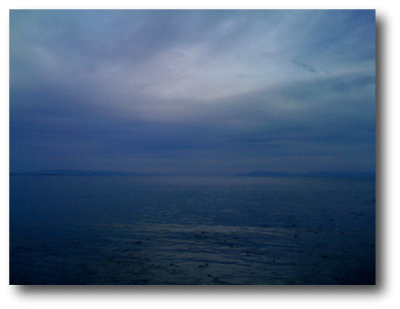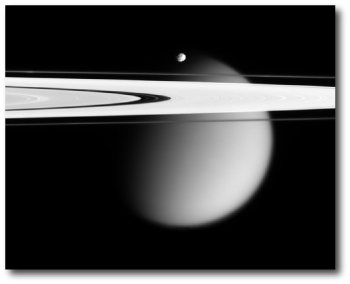
Without regard to order of likelihood, I thought it’d be interesting to lay out a few very specific scenarios by which the first extrasolar world with a 1 million+ habitability valuation could be discovered.
A favorite space-art trope is the habitable moon orbiting the giant planet (which is generally well-endowed with an impressive ring system). Smoggy frigid Titan is the best our solar system can do along these lines, but there’s nothing preventing better opportunities for habitability lying further afield.
I’ve always been intrigued by the fact that the regular satellite systems of the solar system giants each contain of order 2 parts in 10,000 of the mass of the parent planet. At present, there’s no reason to expect that this scaling is any different for extrasolar planets, and given the example of Titan, there doesn’t seem to be anything to prevent the bulk of a given planet’s satellite mass from being tied up in a single large body. Furthermore, since it’s my weblog, I’ll take the liberty of assuming that the satellite mass fraction scales with stellar metallicity.

Image source.
It’s perfectly reasonable to imagine, then, that HD 28185b is accompanied by a 0.63 M_earth, 0.86 R_earth satellite with an orbital radius of a million kilometers. HD 28185b itself has Msin(i)=5.7 Mjup, and the metallicity of HD 28185 is [Fe/H]=+0.24.
Now, for a long shot: let’s assume that on July 11th, 2009, a cadre of small telescope observers in Australia, South Africa and South America discover that HD 28185b transits its parent star. The geometric a-priori odds of the transit are ~0.5%. The expected transit depth is an eminently detectable 1%. A transit of moderate impact parameter lasts about 12 hours.
If a detection is made on July 11th, 2009, it’s a sure thing that the following transit (July 29th, 2010) will be the subject of great scrutiny. The current ground-based state of the art using orthogonal transfer arrays is demonstrating 0.4 mmag photometry with 80 second cadence. At this level, with spot filters and several observatory-class telescopes participating, the piggyback detection of the satellite transit is a many-sigma detection.The cake would be iced on Aug 16th, 2011, when the ~25 second difference in midpoint-to-midpoint intervals would be detected. We’d then be in possession of a potentially habitable terrestrial world warmed by an admirably bright and nearby parent star. Accurate mass and radius determinations would be fully forthcoming. All from the ground, and all at a total cost measured in thousands of dollars of amortized telescope time on existing facilities.
Admittedly, the odds of this specific scenario are slim. I estimate one in two thousand. The payoff, however, is massive. HD 28185bb (with the properties given above) is worth a staggering 100 million dollars. In expectation, then, that’s 50,000 dollars for fully covering the transit window this July…
